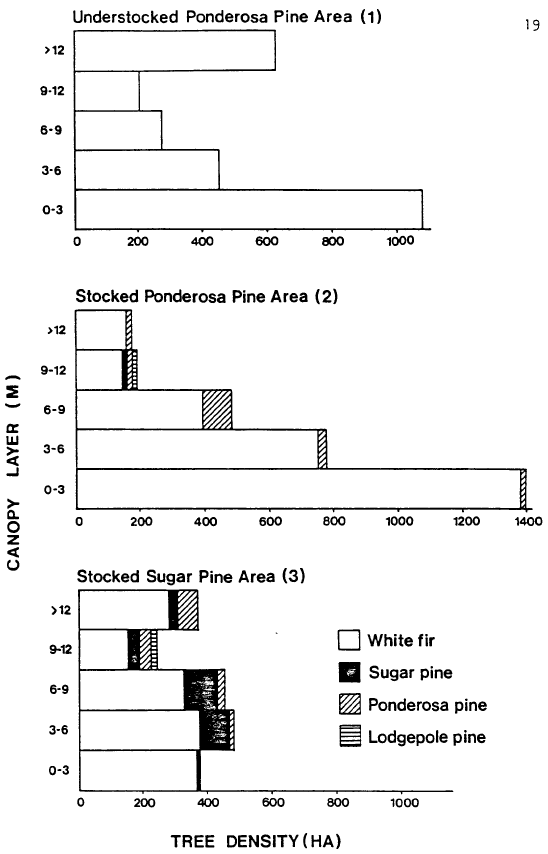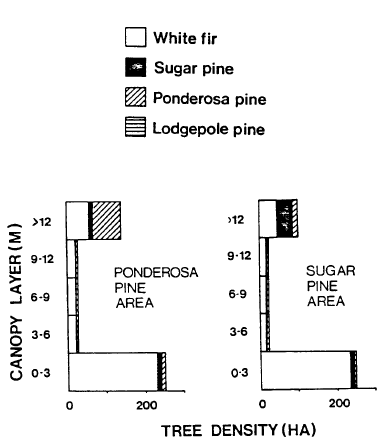Final Report, Forest Restoration of Sun Creek, Crater Lake National Park
Reconnaissance Results
A survey of the logged areas was completed during 1981 to see where the detailed plot information and implications would best apply. A set of 87 plots was uniformly established over the logged areas. From the center point of each plot, stand basal area by species was measured using a 10 factor metric prism. A fixed plot with a 3 m radius was then surveyed at each point. Tree density by species and height class was recorded.
The data were analyzed to determine the adequacy of pine stocking. Areas of adequate or less than adequate stocking were then defined.
Reconnaissance results are summarized in Figures 7 and 8. Three areas were delineated: (1) understocked ponderosa pine area, (2) stocked ponderosa pine area, and (3) stocked sugar pine area.
1. Understocked Ponderosa Pine (355 ha, 875 ac). This area does contain some ponderosa pine, but none showed up on the 36 plots in this type. All stocking recorded was white fir. The average stocking is 2642 trees/ha (1069 trees/ac), about two-thirds of which are below 6 m in height. This stand structure has developed from two changes in disturbance factors. Fire suppression after 1900 initiated a wave of white fir regeneration, which then was released once the overstory pines were logged in the late 1930’s. Fire management alone cannot be used to restore this area to “natural” conditions.
2. Stocked Ponderosa Pine (190 ha, 465 ac). This area contains a number of species of conifers, four of which show up in the sampled plots.
 |
| Figure 7. Reconnaissance map of pine stocking in the Sun Creek logged area. |
White fir is by far the dominant species represented, but some ponderosa pine is represented in each height class. An occasional sugar pine is present, and some lodgepole pine occurs through the area. This area is both adjacent to both the unlogged areas and the “stocked sugar pine” area. Total stocking is 3036 trees/ha (1229 trees/ac), and over two-thirds of trees are below 6 m height. There is enough ponderosa pine present to produce adequate mature stocking if it can be selectively favored on the site; most of it is in the 6-9 m height class at present. Judicious use of fire can largely restore this area to “natural” conditions.
3. Stocked Sugar Pine (120 ha, 300 ac). This area is adjacent to unlogged sugar pine forest, and after the logging both sugar pine and ponderosa pine regenerated. There is adequate stocking to produce a mature “natural” forest, but like the stocked ponderosa pine area, the sugar and ponderosa pine will have to be selectively favored on the site. Fire alone can probably be used to restore this area. Total stocking is 1450 trees/ha (790 trees/ac), less than half of which is in trees below 6 m height.
The reconnaissance plots show current forest structure in three areas of Sun Creek. Based on the dispersion analysis and on the intensive plot data, we have developed an interpretation of how the vertical structure and species composition should appear had fire suppression and logging not occurred (Table 3, Figure 9).
 |
| Figure 8. Vertical structure in Figure 7. by species in the three areas delineated |
The tree densities shown in Figure 9 are crude representations of historic forest structure in the 1800’s. Overstory (>12 m ht) densities for the mid-to-late 1800’s reconstruction were determined from trees exceeding 175 years of age on the plots; densities in the 3-12 m height were determined from trees that germinated between 1805 and 1840, and the 0-3 m height range densities were determined from trees that became established between 1840 and 1875. This underestimates reconstructed density in most classes due to the exclusion of some trees that died before the plots were examined in With the exception of the 0-3 m ht class, though, it is believed that density estimates are within 10-20 percent of actual values. The 0-3 m ht densities fluctuated tremendously, with high mortality after surface fires and substantial regeneration between recurrent fires.
The degree of forest restoration in the logged areas can be assessed by comparing Figures 8 and 9. In the “Understocked Ponderosa Pine Area,” adjustments in density and species composition are needed. In the “Stocked Ponderosa Pine Area” and “Stocked Sugar Pine Area,” density adjustment of white fir only is needed. In unlogged areas (not graphed), similar density adjustments of white fir are needed.
The restoration goal is not to recreate the ecosystems of the 1800’s. It is to recreate what would have existed there today had we not interfered with natural processes. In our opinion, the two goals in this specific case are synonymous. We have no evidence to suggest major shifts In forest structure would have otherwise occurred in unmanaged forests subject to recurring fires over the last century in this area. Therefore, using the late 1800 ecosystem state as a mimic of what should be today’s state is an acceptable assumption for these forests. It would not be as applicable in subalpine forests of the park, where the 1920-1940 drought apparently initiated some significant tree invasion into meadow environments.
***previous*** — ***next***


